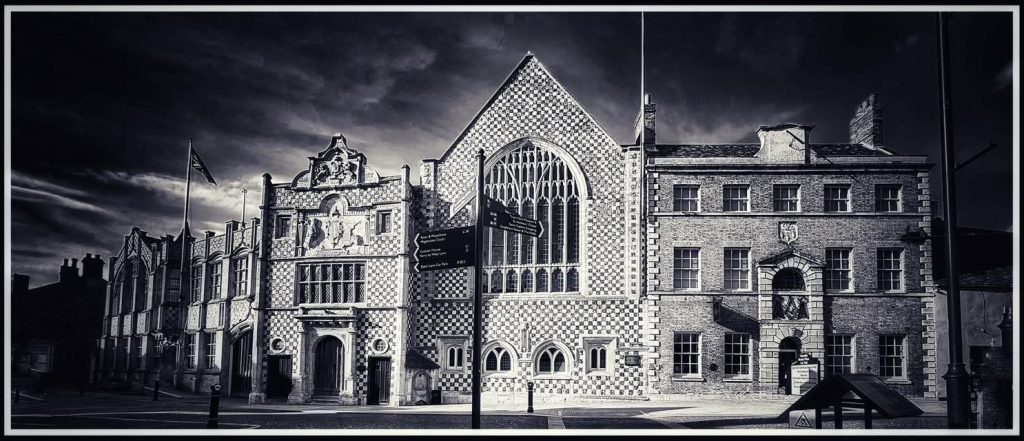Chronological Timeline of King’s Lynn
1100 Years of History
Before 1100 – Saxon Beginnings
- c. 9th–11th centuries: A small coastal community forms around tidal lagoons between the Millfleet and River Nar.
- Economy based on fishing, salt-making, and small-scale trade. The area lies close to the Wash before later silting.
1100–1150 – Founding of the Medieval Town
- 1100: Bishop Herbert de Losinga (of Norwich) founds a new town on reclaimed land north of the Saxon settlement.
- Begins construction of the Priory Church of St Margaret (now King’s Lynn Minster).
- Establishes the Saturday Market Place as the main market area.
- Lenne Episcopi or Bishop’s Lynn.
- Town located between Millfleet and Purfleet, with streets following the riverbanks.

© James Rye 2015
1150–1300 – Expansion under Episcopal Patronage
- c.1150: Bishop Turbe extends the town northwards, creating the “newe lands” between the Purfleet and Fisherfleet.
- Establishes Tuesday Market Place and St Nicholas’s Chapel.
- 1230–1293: Arrival of five orders of friars (Greyfriars, Whitefriars, Blackfriars, Austin Friars, Friars of the Sack).
- 1290s: Original earthwork defences replaced by brick and flint town walls running south to the Purfleet.
- Town prospers as a major East Anglian port; continental trade flourishes, especially in wool exports and Gascon wine imports.
1300–1500 – The Hanseatic Era
- Lynn’s prosperity reaches a peak; by the late 14th century it ranks as England’s third largest port (after London and Southampton).
- Construction of merchant halls and warehouses, including:
- Hampton Court (14th–17th c.)
- Clifton House (13th–17th c.)
- Thoresby College (c.1510)
- Hanseatic Warehouse, St Margaret’s Lane (c.1475).
- St George’s Guildhall built 1422–28 for the Trinity Guild.
- Defensive earthworks strengthened; river gradually shifts west, freeing new land for building along Nelson Street, St Margaret’s Place, and Queen Street.

Photo © James Rye 2021
1500–1600 – Reformation and Local Autonomy
- 1530s–40s: Dissolution of the monasteries; St Margaret’s Priory and friaries suppressed.
- Greyfriars Tower survives as a navigation landmark.
- 1545: Tower formally acquired by the Corporation as a seamark.
- Growth of merchant governance; town increasingly ruled by wealthy traders operating from the Trinity Guildhall.
- No longer Bishop’s Lynn, but Lynn Regis or King’s Lynn
- Construction of fine brick houses with L-shaped or courtyard plans along the riverfront.

Photo © James Rye 2025
1600–1750 – Prosperity and Georgian Refinement
- 1643 The Siege of Lynn
- 1670s: Henry Bell produces his detailed plan of the town, showing a fully built-up St Margaret’s quarter. Builds Custom House and Duke’s Head.
- 1741: Storm damages St Margaret’s Church; south-west spire collapses, leading to rebuilding of the nave (1742–46).
- 1750s–1760s: The Walks created as a public promenade — among England’s earliest municipal parks.
- 18th century: King’s Lynn and Yarmouth become England’s main grain-exporting ports.
- Wealth visible in Georgian façades added to older houses on King Street and Queen Street.
1800–1880 – Industrialisation and Rail Expansion
- 1774-1821 Development of a small Whaling Industry.
- 1803–06: London Road constructed, opening access to southern suburbs.
- 1830: John Wood’s town plan shows two fleets still open waterways.
- 1844: Railway reaches Lynn, diverting much trade from the river.
- 1869: Alexandra Dock built north of Fisher Fleet to take deep-draught ships.
- 1883: Bentinck Dock opens; docks linked by rail.
- Growth of engineering works and shipyards (Savage’s, Aickman’s, Dodman’s, Cooper Bearings).
- The Walks extended with Town Wall Walk (1800–27), later joined by St James’s Park (1903) and St John’s Walk (1906).
1880–1914 – Late Victorian and Edwardian Town
- Public buildings constructed: schools, hospitals, almshouses, and civic buildings (e.g. 1904–05 Carnegie Library).
- South Quay (1855) rebuilt with permanent brick and stone quay walls and mooring bollards.
- Expansion east of the old town with new terraced housing and improved sanitation.

Photo © James Rye 2023
1914–1945 – Early 20th Century and Interwar Years
- Decline in maritime trade; town shifts toward food processing and light industry.
- 1921: War Memorial erected in Tower Gardens.
- 1938: New Head Post Office built on Blackfriars Street.
- Urban housing shortages persist; small terraces and yards become overcrowded.
1945–1970 – Redevelopment and Overspill Growth
- 1958: Campbell’s Soup Factory opens in South Lynn, emblem of the new food industry.
- 1962: London Overspill Scheme doubles population target from 25,000 to 50,000; major housebuilding at Gaywood, North Lynn, and South Lynn.
- 1960s redevelopment: Roughly one-fifth of historic King’s Lynn demolished, mainly between London Road and High Street.
- 1969: King’s Lynn Conservation Area designated, covering St Nicholas’s and St Margaret’s quarters.
- Early 1960s–70s: King’s Lynn Preservation Trust restores key medieval properties; archaeological excavations begin.
1970–2000 – Conservation and Regeneration
- 1979: Conservation area extended after a detailed historic zoning study.
- 1983: Article 4 Direction introduced to restrict unsympathetic alterations (e.g. uPVC windows, concrete tiles).
- 1980s–1990s: Regeneration of redundant warehouses into homes and offices.
- 1990: Caisson bridge installed at Boal Street; new promenade paving at South Quay.
- 1999–2000: King’s Staithe Square refurbished; quay developed as a public waterfront.
Download a Free Idiot’s Guide to the History of King’s Lynn.
© James Rye 2025
Book a Walk with a Trained and Qualified King’s Lynn Guide Through Historic Lynn
Sources
- Borough Council of King’s Lynn and West Norfolk St Margaret’s Area Conservation Area Character Statement (2003)
- Rye, J. (2025) http://www.circato.co.uk/
